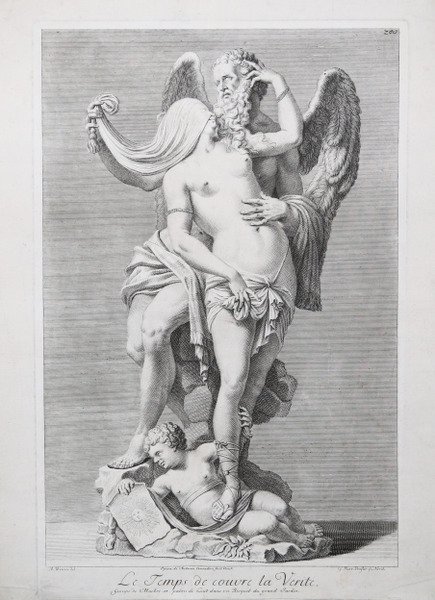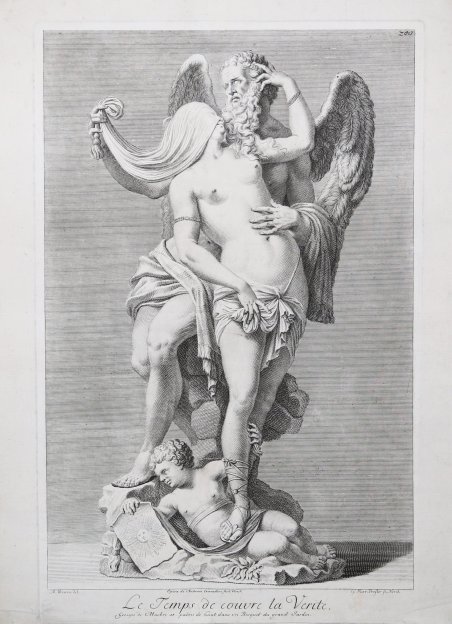Acquaforte e bulino, 1735, firmata in lastra in basso a destra G. Mart, Preisler sc. Norib. Dalla statua di Antonio Corradini nel Großer Garten di Dresda. Sull’esempio dello zar Pietro il Grande, che impreziosì palazzi, residenze estive, giardini di rappresentanza e monumenti russi con opere d’arte provenienti dall’Italia, Augusto II il Forte, Elettore di Sassonia e Re di Polonia, con lo scopo di abbellire la capitale Dresda, mise insieme una enorme collezione di pitture e sculture con l’aiuto di mercanti d’arte e suoi agenti, quali Kinderman e Raymond Le Plat. Vennero coinvolti nell'arredo plastico del parco dell'l’Holländisches Palais, tra gli altri, anche tre scultori attivi a Venezia: oltre ad Antonio Corradini, Pietro Baratta e Filippo Catasio. Nel 1728 l’Holländisches Palais fu interessato da lavori di restauro e le statue ivi presenti furono trasferite al Großer Garten. Durante il rovinoso assedio subito da Dresda nel 1760 molte statue andarono distrutte, mentre nel XIX secolo altre sculture furono vendute sul mercato antiquario. Il parco conserva attualmente solo nove delle dodici opere realizzate da Corradini, che furono tutte illustrate in un catalogo a stampa pubblicato a Dresda nel 1733, curato da Raymond Le Plat. Il gruppo in esame risulta già presente nel parco dell'Holländisches Palais nel 1719 e rappresenta dunque la prima opera realizzata da Corradini per l'elettore di Sassonia; dopo il 1728 venne collocato al Großer Garten (cfr Cogo, 1996) ove tuttora si trova. Come è stato giustamente osservato dalla critica, il soggetto del Tempo che scopre la Verità risulta seguire puntualmente le indicazioni dell'Iconologia di Ripa. Rispetto a tale descrizione mancano attualmente le ali della figura allegorica del Tempo, perdute in data imprecisata ma documentate nell'incisione della raccolta di Le Plat. Opera tratta da ' Recueil des marbres antiques qui se trouvent dans la Galerie du Roy de Pologne à Dresden avec privilege du roy, l'année 1733, pubblicata da Raymond Leplat a Dresda nel 1735. Il catalogo raccoglie, in 230 tavole, la Galleria scultorea, antica e moderna, e altri oggetti artistici posseduti dall’elettore di Sassonia, Federico Augusto I detto Augusto il Forte, morto proprio nel 1733. Il re aveva acquistato arte antica da Federico Guglielmo I di Prussia (compresa la collezione dei ritratti romani di Bellori) e dalle famiglie Chigi e Albani di Roma (sculture, vasi, bronzi e mummie). Sebbene il frontespizio rechi la data del 1733, le tavole recano date anche successive. (1734-1735). Manca un apparato di commento che indichi le provenienze dei pezzi e la maggior parte delle tavole recano solo una breve denominazione dei soggetti, prevalentemente mitologici, raffigurati. Quasi tutte le tavole sono firmate dagli disegnatori e dagli incisori. I disegnatori sono A.M. Wernerin, J. Preissler, M. Tuscher e H. Preissler. Gli incisori L. Zucchi, C.F. Boetius, G. Mart. Preissler, Johann Balthasar Probst, Bernigeroth, Johann David Hertz, Iac. Gottlieb Thelot, Iac. Andr. Fridrich, Christian Philipp Lindemann, Hieronymus Sperling, “MB”, Joh. Jac. Steltzer o Chr. Raym. Thoman. Acquaforte, in ottimo stato di conservazione. Etching and engraving, 1735, signed in plate at lower right G. Mart, Preisler sc. Norib. From the statue of Antonio Corradini in the Großer Garten in Dresden. Following the example of Tsar Peter the Great, who embellished Russian palaces, summer residences, ceremonial gardens, and monuments with works of art from Italy, Augustus II, Elector of Saxony and King of Poland, with the aim of beautifying the capital Dresden, put together a huge collection of paintings and sculptures with the help of art dealers and his agents, such as Kinderman and Raymond Le Plat. Three sculptors active in Venice, among others, were involved in the plastic decoration of the grounds of the Holländisches Palais: in addition to Antonio Corradini, Pietro Baratta and Filippo Catasio. In 1728 the Holländisches Palais underwent restoration work, and the statues there were transferred to the Großer Garten. During the ruinous siege suffered by Dresden in 1760 many statues were destroyed, and in the 19th century other sculptures were sold on the antiques market. The park currently preserves only nine of the twelve works created by Corradini, all of which were illustrated in a printed catalog published in Dresden in 1733, edited by Raymond Le Plat. Plate from ' Recueil des marbres antiques qui se trouvent dans la Galerie du Roy de Pologne à Dresden […], ' published in Dresden by Raymond Le Plat, in 1735. The collection of ancient and modern art at Dresden had been established by Friedrich August I (“Augustus the Strong”), who died in the same year as this book was published. He had bought antiquities from Frederick William I of Prussia (including the Bellori collection of Roman portraits) and from the Chigi and Albani families of Rome (including sculpture, vases, bronzes and mummies). Several Roman antiquities had arrived in Dresden as recently as 1729. The plates have no accompanying explanatory texts, but most are captioned. Subjects are chiefly mythological (the collection includes copies of some famous works, such as Praxiteles's “Satyr” and Scopas's “Maenad tearing a goat”). Almost all the plates are signed by draughtsmen and engravers. The draughtsmen were A.M. Wernerin, Joh. Justin Preissler, M. Tuscher or H. Preissler. The engravers were Lorenzo Zucchi, C.F. Boetius, Georg Mart. Preissler, Johann Balthasar Probst, Bernigeroth, Johann David Hertz, Iac. Gottlieb Thelot, Iac. Andr. Fridrich, Christian Philipp Lindemann, Hieronymus Sperling, “MB”, Joh. Jac. Steltzer or Chr. Raym. Thoman. Etching, in very good condition. Cfr.


Scopri come utilizzare
Scopri come utilizzare

